Image
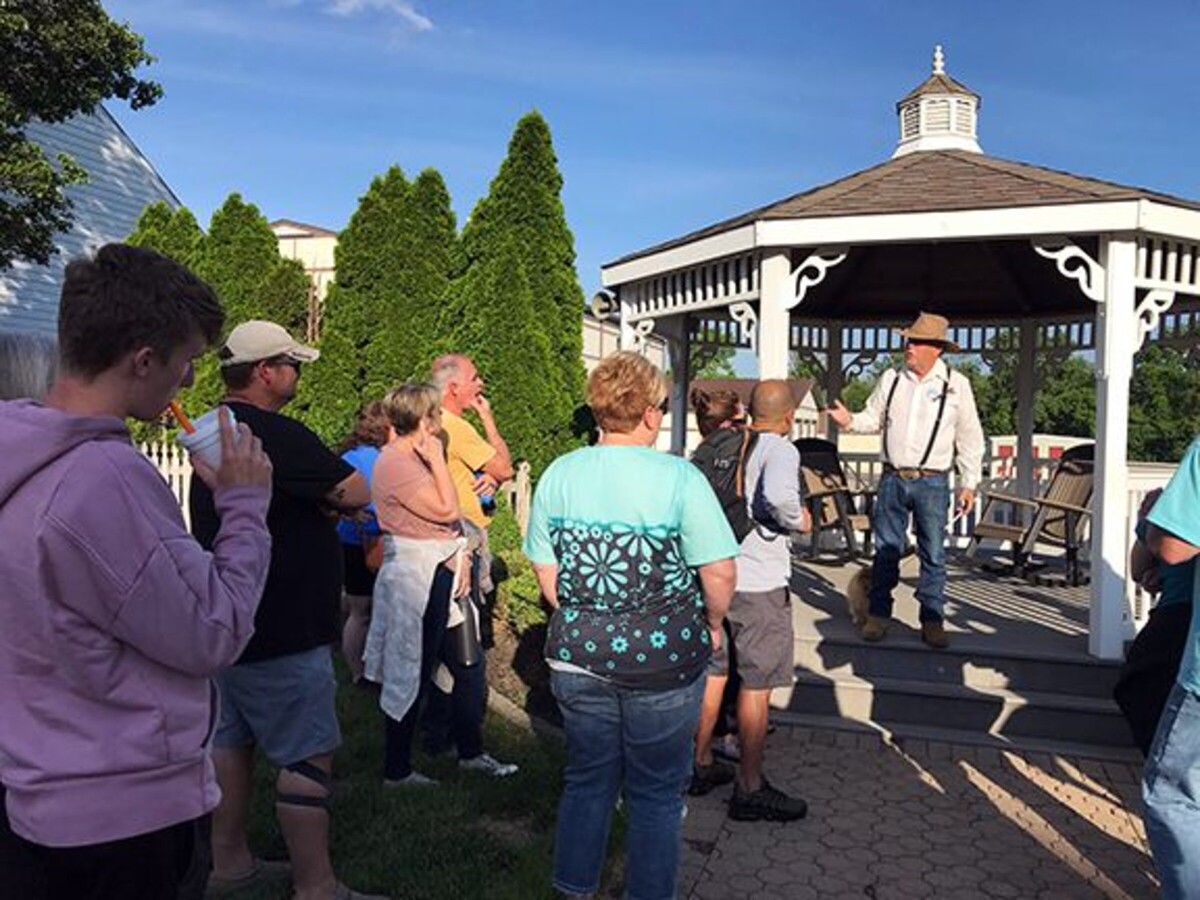

WAYNESVILLE, OH -- When you think Waynesville usually the words like quaint and quiet, antiques, and The Sauerkraut Festival come to mind. And sometimes, the word ghost or haunted might slip out when explaining this historical Warren County Village.
Speaking of ghost, Jim Prickett, one of the tour guides for Waynesville’s Museum at the Friends Home Ghost Tours, invited me on one of the ghost tours earlier this summer. First let me explain, I’m not a big fan of “scary.” I won’t even watch the Wizard of Oz.
“It’s not a scary tour,” Prickett explained to me, adding, “I think you'll like it.”
He was wrong… I loved it!
While many enjoyed hearing the stories on the spirit, ghost, or orb making its presence known to residents and visitors... and they are interesting, I enjoyed the intriguing history behind each stop we made.
“To set the stage, you need to understand this area really was sacred ground,” Prickett said adding, "this is important to understand. People who live in the suburbs aren't going to have these stories of spirits or ghost, since suburbs don't have the years of people history like Waynesville has."
Pickett explained that prior to the "white" settlers moving in around the mid 1700s, the Shawnee Indians owned this ground. But in 1794, General “Mad” Anthony Wayne defeated the American Indian Alliance (led by Little Turtle, Chief of the Myaamia Tribe, and Blue Jacket of the Shawnee) at the Battle of Fallen Timbers. This battle led to the Treaty of Greenville in 1795, which forced tribal leaders to relinquish much of their land to Anglo-Americans. (It is from General Anthony Wayne that Wayne Township and its village Waynesville both get their names.)
While Ohio didn't become a state until 1803, Waynesville had already been settled by 1797 by Samuel Heighway, an engineer from Shropshire, England. Heighway had a dream to make Waynesville the capital of the Northwest Territory. And while that never happened, Waynesville's 225 years as a settled American town is still filled fascinating history and intrigue.
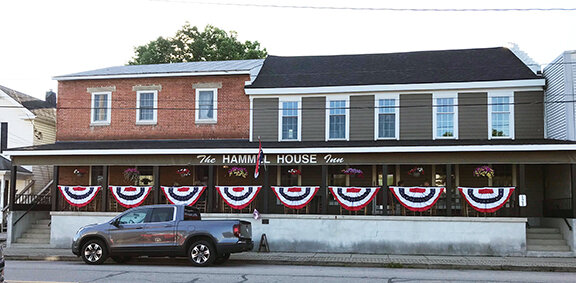 While not the original building, this location has been the site of a bed and board house since 1787. The current building was built in 1817.
While not the original building, this location has been the site of a bed and board house since 1787. The current building was built in 1817.Before we began walking down Main Street to our first scheduled destination on High Street, Prickett pointed to The Hammel House Inn.
“We’ll come back here, but this is the Hammel House,” Prickett said adding that one of the first residents in Waynesville, Mrs. O’Neal, happened to live across from it. Not only did she call it a debauchery, but... “She moved a wagon in front of the Inn so her children would not be able to see the goings-on in it from their home."
Prickett added to hold onto the story as we learned more about the history of the quaint and quiet town as we headed up High Street to Art Expressions and Buckeye Charm.
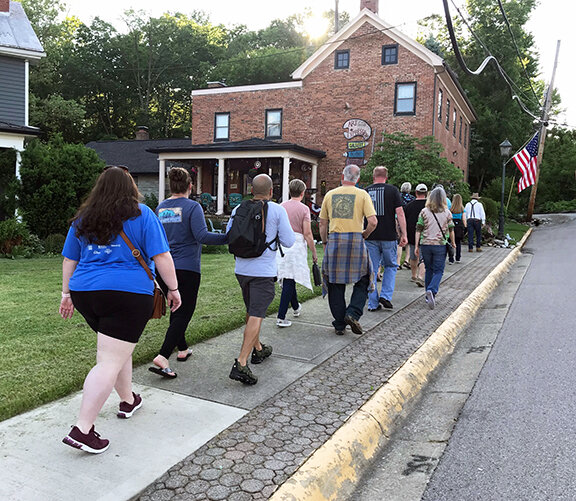 Following Jim to our first stop...Carol & Kevin McNeeley's shop.
Following Jim to our first stop...Carol & Kevin McNeeley's shop.This 1813 house sat empty for eight years before Kevin and Carol McNeeley purchased it five years ago and turned it into a business called Art Expressions that sells different forms of art work, used books and gourmet tea.
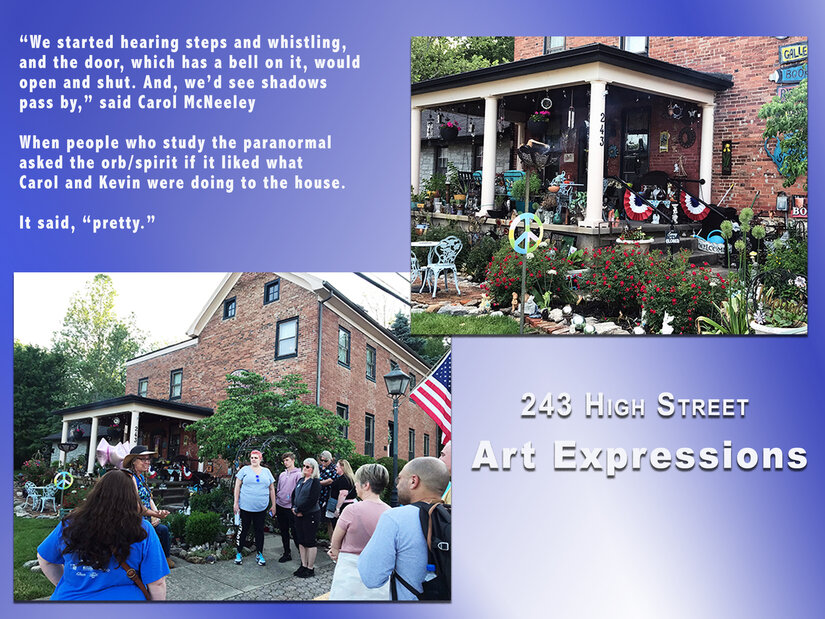 To learn more about Art Expressions click on the above photo.
To learn more about Art Expressions click on the above photo.Once the visit was done there, the group headed across the street to Buckeye Charm. Here the tour group learned the building is an old House of Worship built in 1877 known as St. Augustine’s Catholic Church. Now owned by Jona and Adam Powell, the building is being used as a boutique shop.
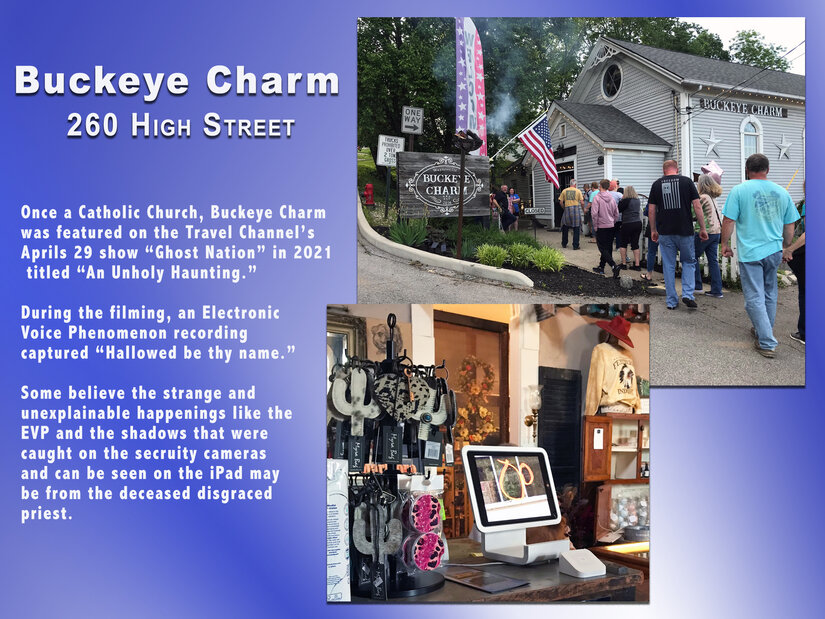 Buckeye Charm used to be St. Augustine Catholic Church.
Buckeye Charm used to be St. Augustine Catholic Church.Next stop, a location where possibly the most horrific act in Warren County happened...a triple hatchet unsolved murder and suicide. The story can be found in both the New York Times and the Boston Pilot. (Click to read the story)
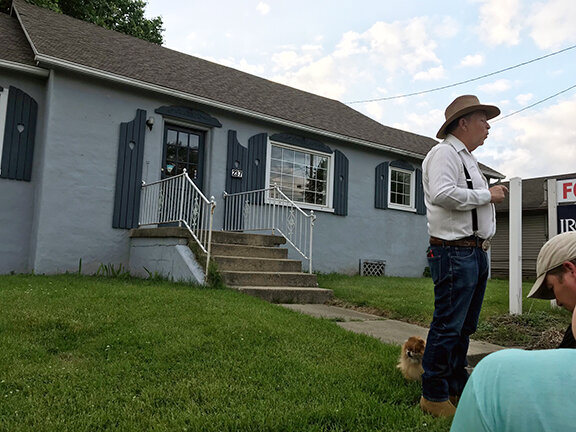 Prickett tells of the triple hatchet murder that happened on this property but not in this house.
Prickett tells of the triple hatchet murder that happened on this property but not in this house."One of the strangest tragedies in the annals of crime has lately occurred in Ohio, and the mystery of it is not likely to be cleared up, since the person who could solve it has himself committed suicide," starts the Boston Pilot newspaper article "A Strange Tragedy."
On August 26, 1879, we learn that a young 18-year-old Willie Anderson was living with his mom, aunt and 12 year old cousin. His father Daniel Anderson lived in Cincinnati. Everything seemed normal.
 The Print Shop where Willie worked
The Print Shop where Willie workedThe next day the house seemed closed up as Willie went to work at the print shop(which is now the candy shop). The neighbors said that everything seemed normal..."he associated with his companions, being light-hearted and cheerful, as his nature was," the report states in the Boston Pilot.
Willie told people his mother and aunt had gone to Cincinnati. He decided to go to Cincinnati himself for the weekend. What triggered the town authorities to check the house was the complaints from the neighbors about the obnoxious smell coming from the house. When looking into the back room, the officer found the bodies of the two women and the young girl, the Pilot reports. Willie's body was found later in coal-shed in Plainville. It was reported he had committed suicide with a pistol.
"The father was taken to Waynesville and examined; but there was no evidence to implicate him and he was discharged," the story reads.
After hearing this horrific story, Prickett pointed across the street to tell us another story... this one was both exciting and very sad.
Across the street from the triple hatchet murder scene sits the second oldest building in Waynesville, Ohio... The Stetson House built in 1810.
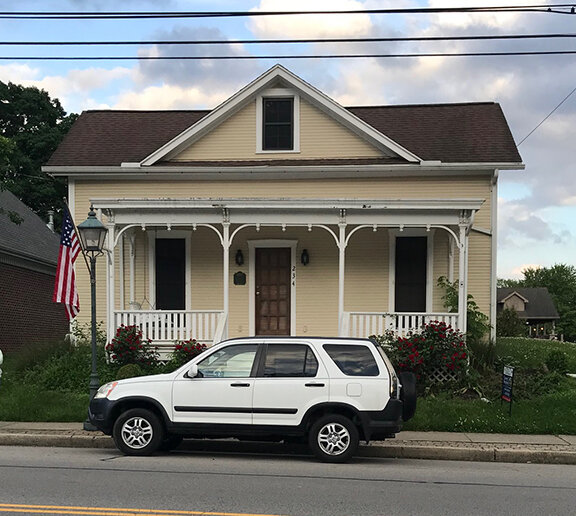 To read about the house click on the photo
To read about the house click on the photoThe house gets its name from Louisa Stetson Larrick, an older sister to John Stetson, who is the inventor and founder of the Stetson Hat Company. Legend has it that while John and Louisa were both from the East Coast, Louisa had moved to Waynesville after marrying into the Larrick Family.
John stopped in to see his sister as he was traveling out west trying to find work and clear his lungs of Tuberculosis in 1854. Being a hat makers son, he found himself making hats from animal hides that people wanted to buy while he was out west.
On his way back east around 1865, he stopped at his sisters who gave him, some say $100 dollars, others say $160... to help him start his hat making business in Philadelphia.
While his business grew and became a huge success, his sister ended up contracting TB and died in 1879.
As far as anyone can tell, Louisa and her family were forgotten by her brother and never benefitted from the family business. Some say her ghost still lingers in the house.
These are just a few of the hundreds of stories that make up the alluring history of Waynesville. There is the Shawnee's history, the Quaker's history, the Underground Railroad history... just to name a few. To learn more about the history of the quaint village nestled in the north eastern part of Warren County visit www.friendshomemuseum.org.